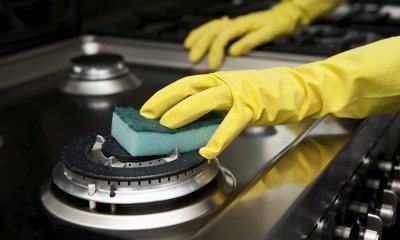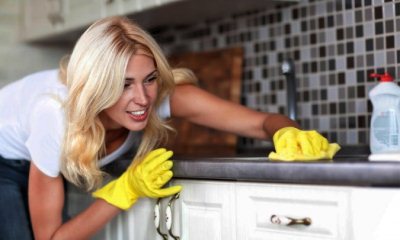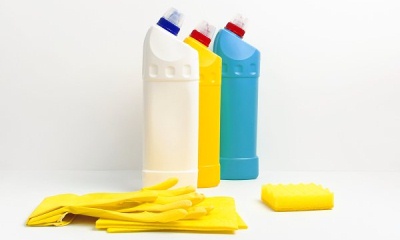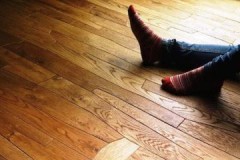Tricks and secrets on how to quickly and easily clean the kitchen
 Cleaning the kitchen is a labor-intensive and lengthy process that takes a lot of energy from housewives. Vanity and haste are bad helpers in this case.
Cleaning the kitchen is a labor-intensive and lengthy process that takes a lot of energy from housewives. Vanity and haste are bad helpers in this case.
Professional advice and life hacks for quick and high-quality cleaning presented in this article will help you choose effective products, optimize the process and significantly reduce the time for putting things in order.
Content
Maintaining consistency
Cleaning of any room is usually carried out from top to bottom., each time moving clockwise. The kitchen is no exception.
Emptying kitchen furniture and returning the contents to their place takes a lot of time, but allows you to quickly and effectively clean surfaces.
Each housewife has her own secrets of spring cleaning, but There is a certain sequence that most people follow:
 Ventilation grilles, window.
Ventilation grilles, window.- Lamps and cornices.
- Fronts, shelves and drawers of cabinets.
- Sockets and switches.
- Window sill and battery.
- Tile on the kitchen apron.
- Hood and stove surface.
- Countertop, sink and faucet.
- Appliances.
- Chair legs.
- Interior doors.
- Floor.
After cleaning, the kitchen area needs an influx of fresh air, so the process should be completed by ventilation.
Cleaning Features
The kitchen is not only the favorite room of the household, but also the place where food is prepared. Specific contaminants on the surface of furniture and appliances are not always removed in a timely manner and become a serious problem. The task is complicated by various materials and the proximity of food products, which are not recommended to come into contact with aggressive components of cleaning products and detergents.
Appliances
The most problematic places in the kitchen are household applianceswho are involved in cooking and storing food. In addition to standard dust and dirt, here the housewife is faced with greasy stains, traces of spilled liquids and carbon deposits. Some simple tips will help you cope with this problem:
Oven
The contents must be removed from it. Soak racks, baking sheets, molds in a detergent solution.
You can find out how to remove carbon deposits in the oven here.
Plate
 If its surface is covered with enamel, Apply detergent and leave for 20 minutesso that the fat and carbon deposits soften.
If its surface is covered with enamel, Apply detergent and leave for 20 minutesso that the fat and carbon deposits soften.
Then treat with a sponge, pay special attention to problem areas around the burners, rinse thoroughly with a clean cloth and dry.
It is not recommended to use products with abrasive particles or hard scourers to avoid scratches.
Steel coating is more resistant to mechanical stress, but stains may remain on it.The processing algorithm for it will be the same, but you should avoid circular movements during cleaning, wipe dry and polish at the end of the process with a cotton cloth. For glass ceramics, only special sponges, scrapers and industrial products are used.
You can find out how to clean the grate of a gas stove from carbon deposits. Here.
Hood
The surfaces of the device can be easily washed with soapy water. The main problem – deposits on a grease filter made of aluminum or steel – may not be dealt with by the product if it has not been washed for several months.
It should be removed and soaked in soap and soda (15 ml of detergent and 50 g of soda), vinegar or ammonia (100 ml per 3.5 liters of water) solution, left for 20-30 minutes, brushed, rinsed with clean water and dried. After all manipulations, the filter is returned to its original place..
Fridge
The first step is to remove the content and revise it. Before cleaning, the appliance must be defrosted; it is better to do this in advance, otherwise the process of general cleaning of the kitchen will be delayed.
The next stage is shelves and containers. All parts must be removed and washed under warm water. sponge or brush with detergent and dry. Proceed to cleaning the back wall of the device (condenser), here it is advisable to use a vacuum cleaner or a narrow brush with a long handle.
Moving from top to bottom, do not miss corners and recesses. Clean the drain hole and rubber seal, wipe everything with a dry cloth and leave the doors open until completely dry. Don’t forget about the outer surface; a weak soap solution will quickly remove all dirt from it.
Before cleaning household appliances, they must be disconnected from the power supply. How to clean a refrigerator, read Here.
Furniture and countertop
Cleaning and disinfecting kitchen floor and wall cabinets, tables and chairs is an important stage of general cleaning. Step-by-step instructions for housewives:
-
 Cleaning the interior surfaces of cabinets. Empty shelves and drawers must be wiped with a microfiber cloth, preferably using a disinfectant spray.
Cleaning the interior surfaces of cabinets. Empty shelves and drawers must be wiped with a microfiber cloth, preferably using a disinfectant spray.The contents are sorted, the excess is sent to the trash and arranged and put into place.
- Treatment of external facades. You will need a soap solution and a sponge. If the furniture is made of wood, it is better to use special household chemicals for this material so as not to damage the structure.
- Washing accessories. Furniture handles absorb most of the dirt; they should be thoroughly treated with a detergent solution. If the parts are removable, it is better to remove them, clean them and return them to their original place. Metal and wood components must be polished using a special spray.
- Cleaning the countertop. The choice of product for these purposes depends on the material from which the table surface is made. For laminated chipboard and MDF, a solution of dishwashing liquid is suitable; for glass, an alcohol-based spray is suitable. To clean a wooden surface, use a minimal amount of liquid, dry thoroughly and polish with a beeswax-based product.
Chairs and stools are wiped last; special attention should be paid to furniture legs.
Floors
The final stage of kitchen cleaning is washing the floor.. For these purposes, it is better to choose household chemicals that cope with various types of contaminants and have antibacterial properties. A product that contains chlorine is fundamentally unsuitable for kitchen floors.
When the equipment and detergent are selected, the following steps must be completed:
- clear the floor of carpets and unnecessary objects (chairs, floor pots);
- sweep and collect small debris, crumbs and food debris;
- treat corners, baseboards, hard-to-reach places with a cloth soaked in detergent;
- wash the entire surface, moving from the window to the exit.
The floor must be treated twice. The second time, the rag must be wrung out well to prevent excess moisture from forming. When working with aggressive and volatile components, it is necessary to use personal protective equipment (gloves, respirators, aprons) and ensure air circulation in the room.
How to clean plumbing fixtures until they shine?
The basis of hygiene in the kitchen is a perfectly clean sink. Step-by-step instructions for cleaning it:
 Remove dirty dishes and cutlery.
Remove dirty dishes and cutlery.- Clean the containers and soap dishes that are placed on it.
- Rinse the walls and bottom of the product with running water to remove any remaining food.
- Apply an industrial or homemade solution to the entire surface.
- Treat with a sponge until completely clean, rinse off any remaining detergent with water.
- Wipe the sink with a dry cloth to avoid streaks.
The sink cleaner should be selected based on the material from which it is made and the manufacturer’s recommendations. The product drain is capable of accumulating fatty deposits and particles of food debris, so it often becomes a source of unpleasant odor and has an unaesthetic appearance.
An industrial product will help remove obsessive aroma and dirt. to remove blockages or baking soda with vinegar (15 g per 50 ml). The liquid must be poured into the hole, left for half an hour, then filled with hot water.
Before using an industrial product, you must study the instructions on the label and make sure it is compatible with the material from which the sink and components are made.
How to eliminate odor from the kitchen sink, will tell you this article.
Other kitchen objects
The window in the kitchen is a source of light and its amount directly depends on the cleanliness of the glass. Cleaning the windows in any room in the same sequencestarting from the inside:
- Use a damp cloth to remove any accumulation of dirt and dust from the glass;
- clean the plastic parts of the structure in the same way, carefully wiping the corners and joints;
- if the contamination is significant, you can prepare a weak soap solution;
- treat the structure with a clean damp cloth and wipe dry;
- Using a spray bottle, apply ammonia-based product to the glass;
- Use a dry lint-free cloth to polish the surface so that there are no streaks left.
You can clean the outside of the window in the same sequence. If access to it is difficult, you can use equipment with a telescopic handle.
 Lamps in the kitchen are an additional source of light. If it is impossible to remove the lighting fixture, You should use the proven instructions:
Lamps in the kitchen are an additional source of light. If it is impossible to remove the lighting fixture, You should use the proven instructions:
- Apply detergent to the chandelier using a spray bottle.
- Wait 10-15 minutes.
- A swab with a small amount of alcohol will help to clean the components and get rid of stains.
- Wipe the product with a dry cloth.
It is not recommended to turn on the device until it is completely dry.
Steel, aluminum or cast iron batteries also require careful care. It is not enough to wipe the external surfaces; the bulk of the dust is concentrated in hard-to-reach places, that is, inside the structure. A vacuum cleaner with a long narrow nozzle, a brush dipped in soapy water, household cloth gloves, sponges and special brushes will help.
Tips on how to organize the inside of your closets
The fact mentioned above is that first you need to free them. Sorting content at the same time can save time. You need to prepare three boxes: the first for unnecessary things that can be thrown away, the second for items that can be given to someone, the third for things that will go back to the closets.
After cleaning the shelves and drawers, they need to be filled. To maintain order longer, You can use the tips of professionals:
- place items where they are most often used;
- do not store food and utensils in one place;
- divide content into categories so you know exactly where to find what you need;
- allocate a shelf for things that are used every day.
It is recommended to store in the upper sections:
- plates and cups;
- groceries;
- storage containers;
- cookbooks.
In the lower ones:
- utensils for cooking;
- household appliances;
- bowls, cups, cutting boards;
- household chemicals.
Features of choosing detergents
There is no universal detergent that would remove stains equally effectively on all surfaces.
Popular forms of release of household chemicals for the kitchen:
 The liquids, often concentrated, are primarily used for cleaning floors.
The liquids, often concentrated, are primarily used for cleaning floors.- Sprays, a sprayer evenly distributes the product over the surface and reduces consumption.
- Gels with and without abrasive particles are thick liquids used for washing dishes, plumbing fixtures, tiles and stoves.
- Powders are used only for hard surfaces that are not prone to mechanical damage (enamel, steel, tiles).
The composition of household chemicals is varied:
- remove various types of contaminants - surfactants, mineral salt, citric acid, betaine;
- destroy fungus and bacteria - formic aldehyde, chlorine;
- promote foam formation - stabilizers, sodium laureth sulfate;
- leave a pleasant aroma - fragrances and flavorings;
- protect the skin of the hands - pH regulators, glycerin, plant extracts.
To choose a suitable product, it is necessary to take into account the material of the surface to be treated, the main types of contamination, and the manufacturer’s recommendations for care. Before use, it is better to carefully study the instructions and strictly follow them. The rating of the best kitchen cleaning products is presented Here.
Professional Services
Cleaning companies cope with general cleaning of kitchen premises quickly, and the result, thanks to professional equipment and household chemicals, is always perfect.
The standard set of services includes:
- Removing cobwebs, dust, dirt, including fatty deposits from external surfaces.
- Washing dishes.
- Plumbing cleaning.
- Furniture, including upholstered furniture.
- Taking out the trash.
For a fee, clients can order window cleaning, organizing cabinets, and cleaning the insides of household appliances.
Average price for services:
- washing dishes – 350;
- oven cleaning – 500;
- microwave oven – 350;
- refrigerator – 500;
- cleaning the inside of cabinets – 500;
- kitchen hood – 300 rubles.
Some companies charge hourly rates. You can find professionals to clean your kitchen through the recommendations of friends, by searching on the Internet, or on specialized contractor search resources.
Lifehacks on how to remove everything quickly
Simple and effective tips will help housewives get rid of dirt in problem areas without using household chemicals and save time:
-
 Limescale deposits on sinks and plumbing fixtures are not aesthetically pleasing; in addition, they can get into drinking water and settle on dishes. Table vinegar will help get rid of it.
Limescale deposits on sinks and plumbing fixtures are not aesthetically pleasing; in addition, they can get into drinking water and settle on dishes. Table vinegar will help get rid of it.It must be applied to a rag and treated problem areas. If the plaque layer is significant, you can make a “compress”.
Cover (wrap) the contaminated surface with a cloth soaked in vinegar solution and leave for 30-60 minutes. The final stage is to wipe the plumbing fixtures dry.Baking paper will help polish the faucet.
- The seams between the tiles can be easily cleaned with a toothbrush and lemon juice. The procedure will remove dirt from problem areas and add a fresh aroma. Instead of freshly squeezed juice, you can use a solution of citric acid and water.
- An alcohol solution will remove stains from kitchen shelves and cabinets. It is recommended to use only a sponge and a soft, dry cloth (preferably microfiber) to polish surfaces. Abrasive cleaners, brushes and steel wool will damage furniture. If there is no serious contamination, you can use a weak solution of detergent for cleaning, but be sure to wash it off with a clean damp cloth so that there are no streaks left.
- Lemon will help clean the microwave oven. It must be cut into slices, placed in a heat-resistant container, filled with 200 ml of water and placed inside the device. Turn on the microwave for 5 minutes at maximum power, then wipe the surface with a soft cloth.
- Baking soda will clean the oven and stove from grease stains. Sprinkle contaminated surfaces and cover with a damp towel. Then thoroughly rinse off the residue and wipe the devices with a dry cloth.
- The refrigerator can be treated with soda and vinegar. There is no need to mix components. Baking soda will remove stains and absorb unpleasant odors, and treating with table vinegar will get rid of mold and pathogens.
- Glass and mirror surfaces must be treated with half a lemon or a weak vinegar solution. A thorough polishing with a lint-free cloth will be required to ensure no streaks remain.
- A solution of soda and water in a ratio of 1:3 or 9% table vinegar can clean cutlery until it shines.The algorithm of actions is the same: moisten the cloth in the liquid, treat the devices with it and rinse them thoroughly in cold water.
Video on the topic of the article
This video will show you how to quickly clean the kitchen:
Conclusion
The kitchen is a problem area in every home. It is necessary to allocate at least 15 minutes daily for cleaning it. Otherwise, grease, carbon deposits, garbage, dirty dishes and an unpleasant odor will take root in it thoroughly and you will no longer be able to do without the help of professional cleaners.


